
The Aerocar Mini-IMP is a light aircraft designed by Moulton Taylor and marketed for homebuilding by Aerocar International. It is a scaled-down derivative of his original Aerocar IMP design. A two-seat version called the Bullet was also built. The Mini-IMP follows the same unconventional layout as its larger predecessor, with a center mounted engine, long driveshaft to a tail propeller, and inverted-V rudder/elevators.
The Aerospace General Mini-Copter was a miniature helicopter designed to be air-dropped to U.S. military pilots stranded behind enemy lines or in otherwise inaccessible areas.

The Albatros L 75 Ass was a German trainer biplane of the 1920s. Of conventional configuration, it seated the pilot and instructor in separate, open cockpits. The wings were single-bay, equal-span, and had a slight stagger. Production continued after Albatros was absorbed by Focke-Wulf.
The Auster Avis was a four-seat light aircraft developed from the Auster Autocrat. It featured a redesigned fuselage incorporating four doors and a circular cross-section towards the tail, new undercarriage, and new wing flaps. It was planned in two versions, the Mk 1 for civil use, and the Mk 2 for military and air ambulance duties. However, only two prototypes were built, and Auster abandoned the project in favour of the Auster J-5 Autocar.
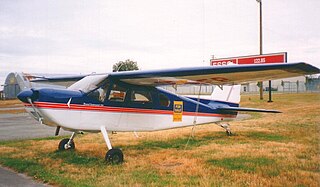
The Found Centennial 100 is a Canadian six-seat cabin monoplane produced by Found Brothers Aviation.
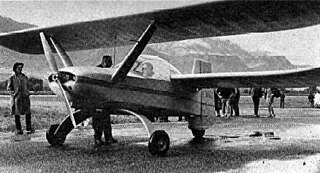
The Croses EC-6 Criquet ("Locust") is a 1960s French two-seat homebuilt aircraft designed by Emilien Croses.
The DSK Airmotive DSK-1 Hawk was an unusual homebuilt aircraft designed in the United States in the early 1970s. While the design itself was utterly conventional - a single-seat low-wing cantilever monoplane with fixed tricycle undercarriage - its method of construction was not, since the DSK-1 Hawk used a surplus 200 US Gal military drop tank as its fuselage. Designer Richard Killingsworth sold over 250 sets of plans.
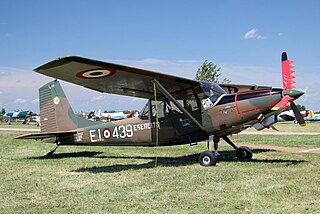
The SIAI-Marchetti SM.1019 is an Italian STOL liaison monoplane built by SIAI-Marchetti for the Italian Army. It is a turboprop-powered derivative of the Cessna O-1 Bird Dog.
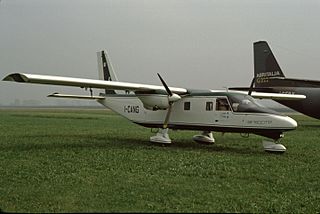
The Vulcanair SF.600 Canguro was a feederliner developed in Italy in the late 1970s. Despite a number of attempts to put the aircraft into series production, only a small number were ever built. The Canguro was a high-wing cantilever monoplane of conventional configuration with a fuselage of rectangular cross-section and a high-set tail. The tricycle undercarriage was not retractable, and its main units were carried on sponsons on the fuselage sides. SIAI Marchetti provided funding towards the construction of the prototype, and constructed this aircraft at the former Aviamilano plant. After flight testing proved positive, the type was put on sale, but failed to attract buyers in any number, even when the original piston engines were exchanged for turboprops and retractable undercarriage was offered as an option.
The Partenavia P.59 Jolly was an Italian two-seat training monoplane designed by Partenavia to meet a requirement for the Aero Club d'Italia. First fight was in 1960.

The IAR-827 was an agricultural aircraft built in Romania in the 1970s and 1980s. The penultimate member of the family of designs that began with the IAR-821, it was, like the others, a conventional low-wing monoplane with fixed, tailwheel undercarriage, and shared the all-metal construction of the IAR-826. The prototype flew in 1976, powered by a Lycoming IO-720 engine, but the production examples that followed all had the PZL-3S.

The Wassmer WA-80 Piranha is a French two-seat low-wing cabin monoplane trainer designed and built by Société Wassmer. Based on the same construction as the company's WA-50 four-seater, the WA-80 was a scaled down version. The prototype, registered F-WVKR, first flew in November 1975 powered by a 100 hp Rolls-Royce Continental O-200 engine. Wassmer appointed a receiver and suspended production in 1977 after 25 had been built.
The Taylorcraft Model 20 Ranch Wagon was a four-seat cabin monoplane designed and built by Taylorcraft Aircraft as a development of the earlier experimental Model 18. The Model 20 was constructed of moulded fibreglass over a tubular framework. It had a conventional landing gear and a nose-mounted 225 hp (168 kW) Continental O-470-J engine.

The Zenair Zenith CH 200 and CH 250 are a family of Canadian single-engined homebuilt light aircraft. It is a low-winged single engine monoplane, that was first flown in France in 1970, with kits being made by the Canadian company Zenair from 1974, with hundreds built and flown.
The IABSA Premier 64-01 was a Brazilian two-seat training and touring braced high-wing monoplane designed and built in small numbers by Industria Aeronáutica Brasileira (IABSA), powered by a 75 hp (56 kW) piston engine.
The Bautek Skycruiser is a German ultralight trike, designed and produced by Bautek of Kenn, Germany. The aircraft is supplied as a complete ready-to-fly-aircraft.
The Flying Machines FM301 Stream, is a Czech ultralight trike, designed by and produced by Flying Machines s.r.o. of Rasošky. The aircraft is supplied as a complete ready-to-fly-aircraft.
The Solid Air Diamant Twin is a German ultralight trike, designed and produced by Solid Air UL-Bau Franz of Hundheim, Rheinland-Pfalz. The aircraft is supplied as a complete ready-to-fly-aircraft.
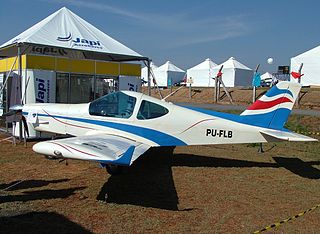
The Storm RG Fury is an Italian microlight aircraft, designed and produced by Storm Aircraft of Sabaudia. Storm Aircraft was originally called SG Aviation srl. The aircraft is supplied complete and ready-to-fly.
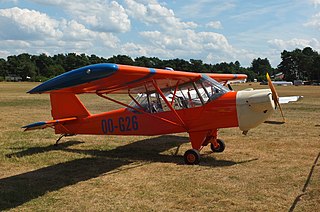
The Ultracraft Calypso is a family of Belgian homebuilt aircraft designed and produced by Ultracraft of Heusden-Zolder, introduced in the 1990s. The aircraft is supplied as a complete ready-to-fly aircraft or as a kit for amateur construction.










